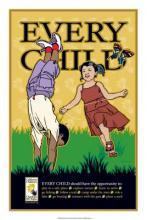
The California Children's Outdoor Bill of Rights (COBR) identifies ten outdoor activities that the California Roundtable on Recreation, Parks and Tourism chose to represent the basic outdoor needs for healthy childhood development. Encompassing such activities as “Play in a safe place” and “Camp under the stars,” their vision is that by the age of 14, all children will participate in these recreational and cultural activities and thus increase the quantity and quality of time they spend in the outdoors.1
In a meeting of the California Roundtable on Recreation, Parks and Tourism in 2001, Marlene Finley of the US Forest Service raised the concern for the child's right to experience nature in our increasingly indoor world of childhood play.2 From this discussion arose the idea of a Bill of Rights to emphasize the importance of outdoor recreation in developing the child and their appreciation of the natural world. They declared that children who do these things “are healthier, do better in school, have better social skills and self-image, and lead more fulfilled lives.”3
After three years of discussion, the final California Children's Outdoor Bill of Rights was adopted on November 10, 2004 and became the theme of the “Connecting Californians to the Outdoors” Roundtable Conference held in 2005 in Los Angeles. Further support came in 2005 with the publication of Richard Louv's book Last Child in the Woods and the public health concern about childhood obesity. In 2007, California Governor Schwarzenegger officially endorsed the California COBR as did the California State Park and Recreation Commission, the California State Alliance of YMCAs, and numerous California counties and cities.4
Early in 2011, the California Roundtable on Recreation, Parks and Tourism began revising the California COBR to eliminate redundancy, include other activities, and utilize language that children would better understand. The revised California Children's Outdoor Bill of Rights, quoted below, was completed in December 2011 and announced on the first day of spring, March 20, 2012.5
“The California Children's Outdoor Bill of Rights provides that every child should have the opportunity to:
Play in a safe place
Explore nature
Learn to swim
Go fishing
Follow a trail
Camp under the stars
Ride a bike
Go boating
Connect with the past
Plant a seed”
The enthusiasm that started in California has spread throughout the country and many other states have begun passing their own versions of a bill of rights for children to play outside and enjoy nature.
The benefit of play is a key underlying principle of the various state COBRs. They recognize that “Play isn't a luxury – it's a necessity. Play is as important to our physical and mental health as getting enough sleep, eating well, and exercising. Play teaches us how to manage and transform our 'negative' emotions and experiences. It supercharges learning, helps us relieve stress, and connects us to others and the world around us.”6
- 1. “Children's Outdoor Bill of Rights.” CA.gov Parks and Recreation. < http://www.parks.ca.gov/?page_id=24952 > 21 March 2012.
- 2. Hasenauer, Jim. Personal correspondence to Playground Professionals. 2 April 2012.
- 3. Op.cit., “Children's Outdoor Bill of Rights.”
- 4. “Endorsements of the 2006 California Children's Outdoor Bill of Rights.” California Roundtable on Recreation, Parks and Tourism. < http://www.calroundtable.org/cobor_endorsements.html > 29 March 2012.
- 5. Op.cit., Hasenauer.
- 6. “Research Bibliography.” California Children's Outdoor Bill of Rights. < http://www.calroundtable.org/files/Research%20Bibliography%20COBR%202012%20%20(3).pdf > 29 March 2012.

